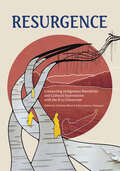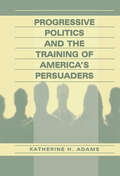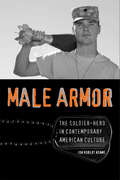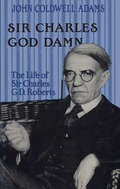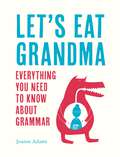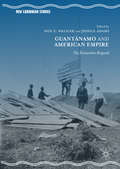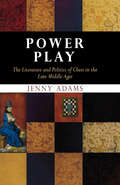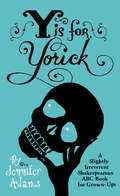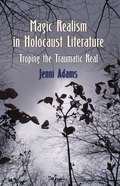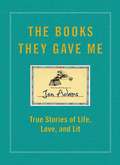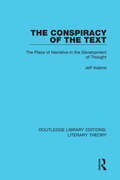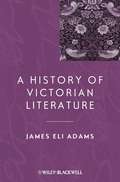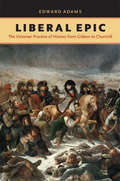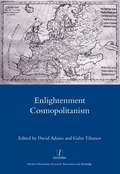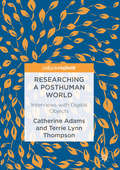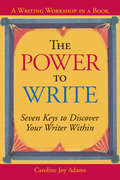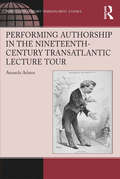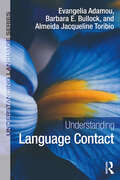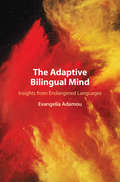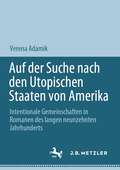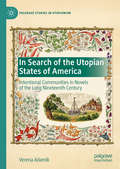- Table View
- List View
Resurgence: Engaging With Indigenous Narratives and Cultural Expressions In and Beyond the Classroom (The Footbridge)
by KC Adams Sonya Ballantyne Charlene Bearhead Wilson Bearhead Lisa Boivin Rita Bouvier Nicola I. Campbell Sara Florence Davidson Louise B. Halfe Lucy Hemphill Wanda John-Kehewin Elizabeth LaPensee Victoria McIntosh Reanna Merasty David A. Robertson Russell Wallace Christina Lavalley Ruddy★ Starred selection for CCBC's Best Books Ideal for Teachers 2023!Resurgence is an inspiring collection of contemporary Indigenous poetry, art, and narratives that guides K–12 educators in bridging existing curricula with Indigenous voices and pedagogies. In this first book in the Footbridge Series, we invite you to walk with us as we seek to: connect peoples and places link truth and reconciliation as ongoing processes symbolize the risk and urgency of this work for both Indigenous and settler educators engage tensions highlight the importance of balance, both of ideas and within ourselves Through critical engagement with each contributor&’s work, experienced educators Christine M&’Lot and Katya Adamov Ferguson support readers in connecting with Indigenous narratives and perspectives, bringing Indigenous works into the classroom, and creating more equitable and sustainable teaching practices. In this resource, you will find: diverse Indigenous voices, perspectives, and art forms from a variety of nations and locations valuable concepts and methods that can be applied to the classroom and beyond practical action steps and resources for educators, parents, librarians, and administrators Use this book as a springboard for your own learning journey or as a lively prompt for dialogue within your professional learning community.
Progressive Politics and the Training of America's Persuaders
by Katherine AdamsAt the beginning of the 20th century, Progressive reformers set up curricula in journalism, public relations, and creative writing to fulfill their own purposes: well-trained rhetors could convince the United States citizenry to accept Progressive thinking on monopolies and unions and to elect reform candidates. Although Progressive politicians and educators envisioned these courses and majors as forwarding their own goals, they could not control the intentions of the graduates thus trained or the employers who hired them. The period's vast panorama of rhetoric, including Theodore Roosevelt's publicity stunts, muckraker exposés, ad campaigns for patent medicines, and the selling of World War I, revealed the new national power of propaganda and the media, especially when wielded by college-trained experts imbued with the Progressive tradition of serving a cause and ensuring social betterment. In this unique volume, Adams' chronicles the creation of this advanced curriculum in speaking and writing during the Progressive era and examines the impact of that curriculum on public discourse. Unlike other studies of writing instruction, which have concentrated on freshman curriculum or on a specific genre, this book provides a historical and cultural analysis of the advanced composition curriculum and of its impact on public persuasion. Adams surveys American instruction at state and private schools across the country, with special attention given to the influential Progressive universities of the Midwest. She draws on a wide variety of primary data sources including college catalogs, course assignments, departmental minutes, speeches, and journals, and includes an extensive bibliography of research sources concerning advanced composition instruction and American rhetoric before World War II. As a resource offering remarkable historical insights on the history of writing instruction in America, this volume is of great interest to scholars and students in rhetoric, communication, and technical writing.
Male Armor: The Soldier-hero in Contemporary American Culture (Cultural Frames, Framing Culture)
by Jon Robert AdamsThere is no shortage of iconic masculine imagery of the soldier in American film and literature--one only has to think of George C. Scott as Patton in front of a giant American flag, Sylvester Stallone as Rambo, or Burt Lancaster rolling around in the surf in From Here to Eternity. In Male Armor, Jon Robert Adams examines the ways in which novels, plays, and films about America's late-twentieth-century wars reflect altering perceptions of masculinity in the culture at large. He highlights the gap between the cultural conception of masculinity and the individual experience of it, and exposes the myth of war as an experience that verifies manhood.Drawing on a wide range of work, from the war novels of Ernest Hemingway, Norman Mailer, James Jones, and Joseph Heller to David Rabe's play Streamers and Anthony Swofford's Jarhead, Adams examines the evolving image of the soldier from World War I to Operation Desert Storm. In discussing these changing perceptions of masculinity, he reveals how works about war in the late twentieth century attempt to eradicate inconsistencies among American civilian conceptions of war, the military's expectations of the soldier, and the soldier's experience of combat. Adams argues that these inconsistencies are largely responsible not only for continuing support of the war enterprise but also for the soldiers' difficulty in reintegration to civilian society upon their return. He intends Male Armor to provide a corrective to the public's continued investment in the war enterprise as a guarantor both of masculinity and, by extension, of the nation.
Sir Charles God Damn: The Life of Sir Charles G.D.Roberts
by John Coldwell AdamsA new era in Canadian poetry began in 1880 with the publication of Charles G.D. Roberts' Orion and Other Poems. He was just twenty years old. Roberts was soon acknowledged as leader of the so-called Confederation Poets--Bliss Carman, Duncan Campbell Scott, and Archibald Lampman. During his long lifetime he wrote hundreds of poems as well as novels, histories, short stories, translations, and essays; he also originated the realistic animal story popularized by Ernest Thompson Seton. He awed literary critics with the versatility of his writing and shocked staid Canadians with the escapades of an unconventional private life. Married at twenty in his native New Brunswick, Roberts soon after began a series of romantic entanglements. While his wife, May, raised the children in Fredericton, he swanned around New York, Havana, and the capitals of Europe. He experienced the Bohemian life of Washington Square around the turn of the century and lived in Montparnasse long before it became famous as an expatriate haven. In 1907 he sailed off to Europe and stayed for eighteen years. When he finally returned aboard the Berengaria in 1925 for a reading tour, he was lionized from coast to coast. For almost two decades he remained a prominent figure in Canadian literary and social circles. He was national president of the Canadian Authors' Association from 1927 to 1929, and in 1935 he was knighted. At the age of eighty-three, just three weeks before his death in 1943, he married for a second time. Perhaps over-praised as a writer in his own lifetime, Roberts' reputation has since languished. His main literary achievement, Adams concludes, was in being the first Canadian writer to come to terms with the Canadian landscape, influencing his contemporaries to see their own surroundings with fresh and discerning eyes. The story of his personal life, recounted here fully and objectively for the first time, adds a vivid portrait to the gallery of Canada's literary pioneers.
Let's Eat Grandma: Everything You Need to Know About Grammar
by Joanne Adamshttp://www.stisonbooks.com/images/books/native/9781786851451
Guantánamo and American Empire: The Humanities Respond (New Caribbean Studies)
by Jessica Adams Don E. WalicekThis book explores the humanities as an insightful platform for understanding and responding to the military prison at Guantánamo Bay, other manifestations of “Guantánamo,” and the contested place of freedom in American Empire. It presents the work of scholars and writers based in Cuba’s Guantánamo Province and various parts of the US. Its essays, short stories, poetry, and other texts engage the far-reaching meaning and significance of Gitmo by bringing together what happens on the U.S. side of the fence—or “la cerca,” as it is called in Cuba—with perspectives from the outside world. Chapters include critiques of artistic renderings of the Guantánamo region; historical narratives contemplating the significance of freedom; analyses of the ways the base and region inform the Cuban imaginary; and fiction and poetry published for the first time in English. Not simply a critique of imperialism, this volume presents politically engaged commentary that suggests a way forward for a site of global contact and conflict.
Power Play
by Jenny AdamsThe game of chess reached western Europe by the year 1000, and within several generations it had become one of the most popular pastimes ever. Both men and women, and even priests played the game despite the Catholic Church's repeated prohibitions. Characters in countless romances, chansons de geste, and moral tales of the eleventh through twelfth centuries also played chess, which often symbolized romantic attraction or sexual consummation.In Power Play, Jenny Adams looks to medieval literary representations to ask what they can tell us both about the ways the game changed as it was naturalized in the West and about the society these changes reflected. In its Western form, chess featured a queen rather than a counselor, a judge or bishop rather than an elephant, a knight rather than a horse; in some manifestations, even the pawns were differentiated into artisans, farmers, and tradespeople with discrete identities.Power Play is the first book to ask why chess became so popular so quickly, why its pieces were altered, and what the consequences of these changes were. More than pleasure was at stake, Adams contends. As allegorists and political theorists connected the moves of the pieces to their real-life counterparts, chess took on important symbolic power. For these writers and others, the game provided a means to figure both human interactions and institutions, to envision a civic order not necessarily dominated by a king, and to imagine a society whose members acted in concert, bound together by contractual and economic ties. The pieces on the chessboard were more than subjects; they were individuals, playing by the rules.
Y is for Yorick: A Slightly Irreverent Shakespearean Abc Book For Grown-ups
by Jennifer AdamsThis delightfully illustrated ABC book for grown-ups offers a fresh and irreverent take on Shakespeare&’s most memorable characters. The plays of William Shakespeare contain some of the most renowned characters and stories in all of literature. The perfect gift for any fan of The Bard, Y is for Yorick takes playful jabs at the unforgettable plots and people we all know and love. From Ariel (of The Tempest) to Elizabeth (of Richard III), each entry combines amusing illustrations with tongue-in-cheek captions about each character.
Magic Realism in Holocaust Literature
by Jenni AdamsA major contribution to Holocaust studies, the book examines the capacity of supernatural elements to dramatize the ethical and representational difficulties of Holocaust fiction. Exploring texts by such writers as D. M. Thomas and Markus Zusak it will appeal to scholars and students of Holocaust literature, magic realism, and contemporary fiction.
The Books They Gave Me: True Stories of Life, Love, and Lit
by Jen AdamsThis beautiful full-color treasury of stories about gift book-giving celebrates the enduring power of literature: stories of significant books people have received and what those books mean to them.THE GIFT OF A BOOK BECOMES PART OF THE STORY OF YOUR LIFE. Perhaps it came with a note as simple as "This made me think of you," but it takes up residence in your heart and your home. The Books They Gave Me is a mixtape of stories behind books given and received. Some of the stories are poignant, some snarky, some romantic, some disastrous--but all are illuminating. Jen Adams collected nearly two hundred of the most provocative stories submitted to the tumblr blog TheBooksTheyGaveMe.com to capture the many ways books can change our lives and loves, revealing volumes about the relationships that inspired the gifts. These stories are, by turns, romantic, cynical, funny, dark, and hopeful. There's the poorly thought out gift of Lolita from a thirty-year-old man to a teenage girl. There's the couple who tried to read Ulysses together over the course of their long-distance relationship and never finished it. There's the girl whose school library wouldn't allow her to check out Fahrenheit 451, but who received it at Christmas with the note, "Little Sister: Read everything you can. Subvert Authority! Love always, your big brother." These are stories of people falling in love, regretting mistakes, and finding hope. Together they constitute a love letter to the book as physical object and inspiration. Illustrated in full color with the jackets of beloved editions, The Books They Gave Me is, above all, an uplifting testament to the power of literature.
The Books They Gave Me
by Jen AdamsTHE GIFT OF A BOOK BECOMES PART OF THE STORY OF YOUR LIFE. Perhaps it came with a note as simple as "This made me think of you," but it takes up residence in your heart and your home. The Books They Gave Me is a mixtape of stories behind books given and received. Some of the stories are poignant, some snarky, some romantic, some disastrous--but all are illuminating. Jen Adams collected nearly two hundred of the most provocative stories submitted to the tumblr blog TheBooksTheyGaveMe.com to capture the many ways books can change our lives and loves, revealing volumes about the relationships that inspired the gifts. These stories are, by turns, romantic, cynical, funny, dark, and hopeful. There's the poorly thought out gift of Lolita from a thirty-year-old man to a teenage girl. There's the couple who tried to read Ulysses together over the course of their long-distance relationship and never finished it. There's the girl whose school library wouldn't allow her to check out Fahrenheit 451, but who received it at Christmas with the note, "Little Sister: Read everything you can. Subvert Authority! Love always, your big brother." These are stories of people falling in love, regretting mistakes, and finding hope. Together they constitute a love letter to the book as physical object and inspiration. Illustrated in full color with the jackets of beloved editions, The Books They Gave Me is, above all, an uplifting testament to the power of literature.
The Conspiracy of the Text: The Place of Narrative in the Development of Thought (Routledge Library Editions: Literary Theory #1)
by Jeff AdamsIn The Conspiracy of the Text, first published in 1986, Jeff Adams looks at an early stage in childhood to examine the ways in which children create social organisation and moral order. Adams shows how certain narratives, such as fairy tales, serve as a foundation for this system, and does this through a fascinating linguistic analysis of a young girl’s reading of her favourite fairy tale, Beauty and the Beast. This title will be of interest to students of literary theory and linguistics.
A History of Victorian Literature (Blackwell History of Literature #11)
by James Eli AdamsIncorporating a broad range of contemporary scholarship, A History of Victorian Literature presents an overview of the literature produced in Great Britain between 1830 and 1900, with fresh consideration of both major figures and some of the era's less familiar authors. Part of the Blackwell Histories of Literature series, the book describes the development of the Victorian literary movement and places it within its cultural, social and political context. A wide-ranging narrative overview of literature in Great Britain between 1830 and 1900, capturing the extraordinary variety of literary output produced during this era Analyzes the development of all literary forms during this period - the novel, poetry, drama, autobiography and critical prose - in conjunction with major developments in social and intellectual history Considers the ways in which writers engaged with new forms of social responsibility in their work, as Britain transformed into the world's first industrial economy Offers a fresh perspective on the work of both major figures and some of the era’s less familiar authors Winner of a Choice Outstanding Academic Title award, 2009
Social Variation and the Latin Language
by J. N. AdamsLanguages show variations according to the social class of speakers and Latin was no exception, as readers of Petronius are aware. The Romance languages have traditionally been regarded as developing out of a 'language of the common people' (Vulgar Latin), but studies of modern languages demonstrate that linguistic change does not merely come, in the social sense, 'from below'. There is change from above, as prestige usages work their way down the social scale, and change may also occur across the social classes. This book is a history of many of the developments undergone by the Latin language as it changed into Romance, demonstrating the varying social levels at which change was initiated. About thirty topics are dealt with, many of them more systematically than ever before. Discussions often start in the early Republic with Plautus, and the book is as much about the literary language as about informal varieties.
Critical Theory Since Plato
by Hazard AdamsA collection of literary works from the Western Cannon which give insight into critical theory over the past 2000 years. There are both excerpts from primary texts and commentary. Selections come from authors including Dante, Locke, Shakespeare, Keats, and many more.
Liberal Epic: The Victorian Practice of History from Gibbon to Churchill (Victorian Literature and Culture Series)
by Edward AdamsIn Liberal Epic, Edward Adams examines the liberal imagination's centuries-long dependence on contradictory, and mutually constitutive, attitudes toward violent domination. Adams centers his ambitious analysis on a series of major epic poems, histories, and historical novels, including Dryden's Aeneid, Pope's Iliad, Gibbon's Decline and Fall of the Roman Empire, Byron's Don Juan, Scott's Life of Napoleon, Napier's History of the War in the Peninsula, Macaulay's History of England, Hardy's Dynasts, and Churchill's military histories--works that rank among the most important publishing events of the past three centuries yet that have seldom received critical attention relative to their importance. In recovering these neglected works and gathering them together as part of a self-conscious literary tradition here defined as liberal epic, Adams provides an archaeology that sheds light on contemporary issues such as the relation of liberalism to war, the tactics for sanitizing heroism, and the appeal of violence to supposedly humane readers. Victorian Literature and Culture Series
The Noisy Book Starring Yakety Yak
by Edith AdamsYakety Yak can't stop making noise until one day his neighbor's notice a difference. Is Yak trying to please his neighbors? Or...
Enlightenment Cosmopolitanism
by David AdamsEnlightenment Cosmopolitanism brings together ten innovative contributions by outstanding scholars working across a wide array of disciplines in the humanities and social sciences. Interdisciplinary in its methodology and compass, with a strong comparative European dimension, the volume examines discourses ranging from literature, historiography, music and opera to anthropology and political philosophy. It makes an original contribution to the study of 18th-century ideas of universal peace, progress and wealth as the foundation of future debates on cosmopolitanism. At the same time, it analyses examples of counter-reaction to these ideas and discusses the relevance of the Enlightenment for subsequent polemics on cosmopolitanism, including 21st-century debates in sociology, politics and legal theory.
Researching a Posthuman World: Interviews with Digital Objects
by Catherine Adams Terrie Lynn ThompsonThis book provides a practical approach for applying posthumanist insights to qualitative research inquiry. Adams and Thompson invite readers to embrace their inner – and outer – cyborg as they consider how today’s professional practices and everyday ways of being are increasingly intertwined with digital technologies. Drawing on posthuman scholarship, the authors offer eight heuristics for “interviewing objects” in an effort to reveal the unique – and sometimes contradictory – contributions the digital is making to work, learning and living. The heuristics are drawn from Actor Network Theory, phenomenology, postphenomenology, critical media studies and related sociomaterial approaches. This text offers a theoretically informed yet practical approach for asking critical questions of digital and non-digital things in professional and personal spaces, and ultimately, for considering the ethical and political implications of a technology mediated world. A thought-provoking and innovative study, this book will be of great interest to scholars and researchers of technology studies, digital learning, and sociology.
The Power to Write: A Writing Workshop in a Book
by Caroline Joy AdamsA writing workshop in a book! Writing teacher and artist/calligrapher Adams knows the tremendous power of the written word. And she has made it her mission to put into action her belief that everyone can experience and enjoy this power and the fruits of her or his own creativity. Many can write, but few do. Why? Fear stops us, Adams writes. Fear, not knowing how to get started, and the lack of inspiration. Having discovered these truths while teaching her numerous writing workshops, Adams has put them into The Power to Write and created a writing workshop in a book. Readers can use it alone or form their own groups.
Performing Authorship in the Nineteenth-Century Transatlantic Lecture Tour (Ashgate Series in Nineteenth-Century Transatlantic Studies)
by Amanda AdamsExpanding our understanding of what it meant to be a nineteenth-century author, Amanda Adams takes up the concept of performative, embodied authorship in relationship to the transatlantic lecture tour. Adams argues that these tours were a central aspect of nineteenth-century authorship, at a time when authors were becoming celebrities and celebrities were international. Spanning the years from 1834 to 1904, Adams’s book examines the British lecture tours of American authors such as Frederick Douglass, Harriet Beecher Stowe, and Mark Twain, and the American lecture tours of British writers that include Harriet Martineau, Charles Dickens, Oscar Wilde, and Matthew Arnold. Adams concludes her study with a discussion of Henry James, whose American lecture tour took place after a decades-long absence. In highlighting the wide range of authors who participated in this phenomenon, Adams makes a case for the lecture tour as a microcosm for nineteenth-century authorship in all its contradictions and complexity.
Understanding Language Contact (Understanding Language)
by Evangelia Adamou Barbara E. Bullock Almeida Jacqueline ToribioUnderstanding Language Contact offers an accessible and empirically grounded introduction to contact linguistics. Rather than taking a traditional focus on the outcomes of language contact, this book takes the novel approach of considering these outcomes as an endpoint of bilingualism and multilingualism. Covering speech production and comprehension, language diffusion across different interactional networks and timeframes, and the historical outcomes of contact-induced language change, this book: Discusses both how these areas relate to one another and how they correspond to different theoretical fields and methodologies; Draws together concepts and methodological/theoretical advances from the related fields of bilingualism and sociolinguistics to show how these can shed new light on the traditional field of contact linguistics; Presents up-to-date research in a digestible form; Includes examples from a wide range of contact languages, including Creoles and pidgins; Indigenous, minority, and heritage languages; mixed languages; and immigrants' linguistic practices, to illustrate ideas and concepts; Features exercises to test students’ understanding as well as suggestions for further reading to expand knowledge in specific areas. Written by three experienced teachers and researchers in this area, Understanding Language Contact is key reading for advanced undergraduate and postgraduate students approaching bilingualism and language contact for the first time.
The Adaptive Bilingual Mind: Insights from Endangered Languages
by Evangelia AdamouAt present, much of the research on bilingual cognition focuses on late second language learners of a small number of languages. In this fascinating book, Evangelia Adamou widens the net by integrating advances in the field of bilingualism with the study of endangered languages. Drawing on recent studies from Europe and Latin America, she demonstrates that experimental psycholinguistic methods can be successfully applied outside the lab and, conversely, how data from these understudied populations provide new insights into the adaptive capacities of the bilingual mind. Adamou shows how bilinguals manage competing conceptualizations of time and space, how their grammars and language mixing patterns adapt to cognitive constraints such as the need for simplification, and how language processing concurrently adapts to their complex bilingual experience. Combining statistical analyses with detailed linguistic and ethnographic information, this essential book will appeal to scholars of bilingualism, cognitive sciences, language endangerment, and language contact.
Auf der Suche nach den Utopischen Staaten von Amerika: Intentionale Gemeinschaften in Romanen des langen neunzehnten Jahrhunderts
by Verena AdamikIn diesem Buch wird versucht, die scheinbar direkte Verbindung zwischen Utopismus und den USA zu verstehen, indem Romane besprochen werden, die in dieser Kombination noch nie zusammengebracht wurden, obwohl sie sich alle um intentionale Gemeinschaften drehen: Imlays The Emigrants (1793), Hawthornes The Blithedale Romance (1852), Howlands Papas Own Girl (1874), Griggs' Imperium in Imperio (1899), und Du Bois' The Quest of the Silver Fleece (1911). Sie setzen Nation und Utopie nicht in Beziehung, indem sie perfekte Gesellschaften beschreiben, sondern indem sie über Versuche schreiben, unmittelbar ein radikal anderes Leben zu führen. Indem die Lektüre die jeweilige kommunale Geschichte aufzeigt, bietet sie eine literarische Perspektive für kommunale Studien und trägt zu einer dringend notwendigen Historisierung für rein literarische Ansätze zum US-Utopismus und für Studien bei, die sich auf Pilgrims/Puritans/Gründerväter als utopische Praxis konzentrieren. Das Buch zeigt daher auf, wie die Autoren das utopische Potenzial der USA bewerteten, und zeichnet die Entwicklung der utopischen Vorstellungskraft im neunzehnten Jahrhundert aus verschiedenen Perspektiven nach.
In Search of the Utopian States of America: Intentional Communities in Novels of the Long Nineteenth Century (Palgrave Studies in Utopianism)
by Verena AdamikThis book endeavours to understand the seemingly direct link between utopianism and the USA, discussing novels that have never been brought together in this combination before, even though they all revolve around intentional communities: Imlay’s The Emigrants (1793), Hawthorne’s The Blithedale Romance (1852), Howland’s Papas Own Girl (1874), Griggs’s Imperium in Imperio (1899), and Du Bois’s The Quest of the Silver Fleece (1911). They relate nation and utopia not by describing perfect societies, but by writing about attempts to immediately live radically different lives. Signposting the respective communal history, the readings provide a literary perspective to communal studies, and add to a deeply necessary historicization for strictly literary approaches to US utopianism, and for studies that focus on Pilgrims/Puritans/Founding Fathers as utopian practitioners. This book therefore highlights how the authors evaluated the USA’s utopian potential and traces the nineteenth-century development of the utopian imagination from various perspectives.
